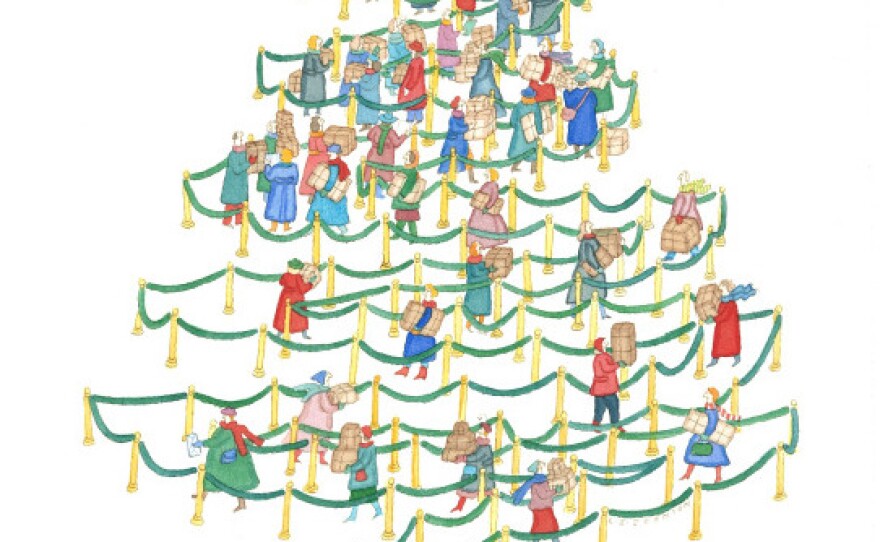It's not often you see an image of a brain scan on the wall of an art exhibit. But among works by Monet and Sisley at the Walters Art Museum in Baltimore hangs just that — a cross section of a human brain. It belongs to artist Lonni Sue Johnson.
The room is really two exhibits — the art Johnson created before she contracted viral encephalitis in 2007, which destroyed her hippocampus and parts of her left temporal lobe — and her work after.

This work, called The Christmas Tree Line, is one of Johnson's famous pieces that ran in The New Yorker in 1985 well before she became ill. It has layers of meaning if you look at it closely, says Barbara Landau, a professor of cognitive science at Johns Hopkins University.
The work on the other side of the room is simpler, almost childlike: colored-pencil sketches, still bright and cheerful but very different from the artwork before her brain damage. Grids filled with letters in what appear to be crossword puzzles shaped like objects.
The encephalitis took away many of Johnson's old memories, like her marriage of 10 years and her illustrious art career. But the way she was able to retain certain other memories — and her ability to draw — are mysteries.
So about once a month, a team of researchers from Johns Hopkins visits Johnson in the Princeton, N.J., area. They aim to learn more about what she remembers — and why word puzzles are able to unlock her mind and return it to art.
The Effects Of The Illness
Barbara Landau, a professor of cognitive science at Hopkins who has known Johnson since high school, has been working with her ever since the illness left gaping holes in her brain. Landau points out a section of the brain scan.
"Severe hippocampal damage would predict that you would not be able to form new memories, and that means that you're amnesic for experiences that you have on a day-to-day basis," she says.
Johnson's amnesia today is a dramatic improvement over her condition in late 2007. She was spending Christmas alone at her home in Vermont. One afternoon, a local farmer noticed Johnson through the window. She was staring at her computer mouse, not moving.

In 2007, artist Lonni Sue Johnson contracted viral encephalitis, which destroyed her hippocampus and parts of her left temporal lobe. Since then, she has continued to create art. It's just different.
"She would look at one hand — the palm — and then turn that hand over, look at the back of her hand, and then the front of the hand," Aline says. "And back and forth and then look over to the other hand — just mystified."
Aline says at first her sister couldn't walk, talk or eat.
"She gained her ability to talk, I would say, over the course of a year," Aline says. "When she first started speaking, she was unable to say any nouns. So she would talk and talk, and we had no idea what she was talking about — we were waiting for the end of a sentence where there might be a noun and no noun came."
Word Puzzles Unlock The Brain
But language would soon become the key to unlocking parts of Johnson's mind.
As she regained her ability to speak, Johnson began to create word puzzles. And now, those puzzles serve as a kind of bridge to her return to art.
"She lives in a narrow sliver of the present moment, not well connected to what just happened," Aline says. "And with her puzzles, she's able to capture what's going on in a way that she can use her creative energies. And that's one scaffolding. Another is the alphabet. Because, for example, when she's singing an alphabet song and she's at the letter 'M,' she knows where she's come from, she knows where she's going to. So it gives her a feeling of continuity, of the flow of time, which she might not otherwise be able to get."
But language and drawing aren't the only talents that returned.
Johnson also remembers how to play viola, something she'd learned before her illness.
The researchers at Johns Hopkins are hoping Johnson can help unravel some of the mysteries of memory. Why does Johnson remember her mother and sister and her viola lessons, but little else from her life? She's missing a hippocampus — but she can still learn new things.
Copyright 2022 NPR. To see more, visit https://www.npr.org. 9(MDAzMjM2NDYzMDEyMzc1Njk5NjAxNzY3OQ001))







